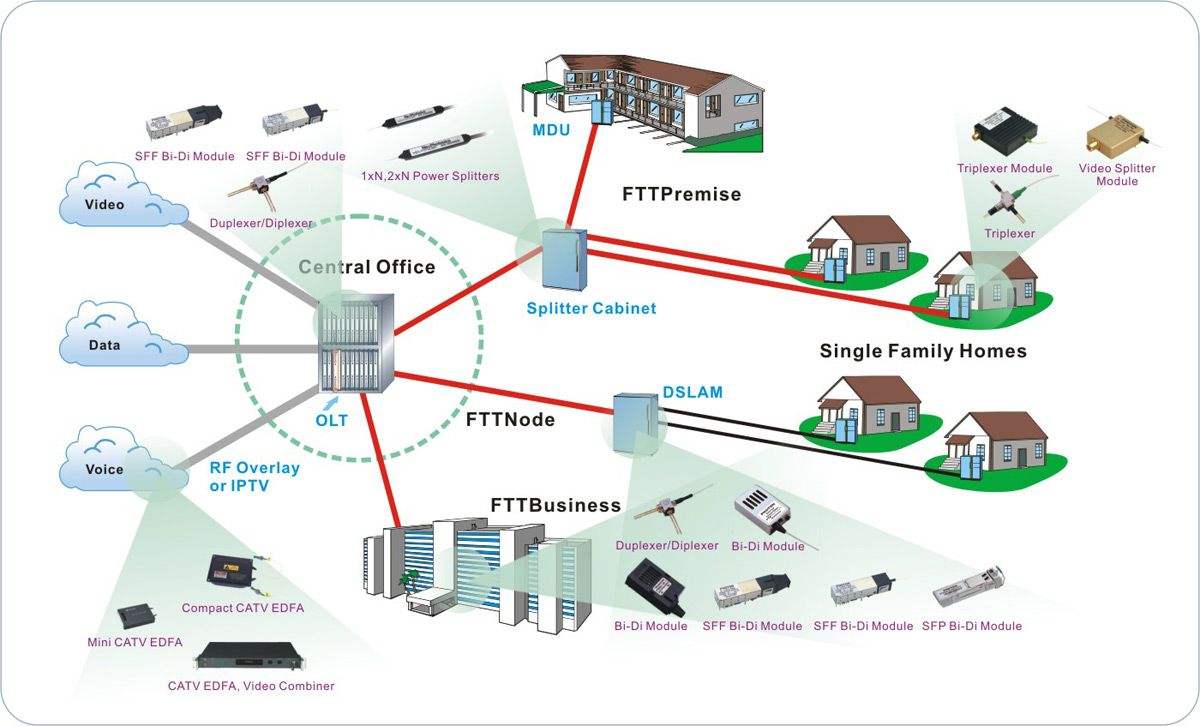Fiber-to-the-home (FTTP)
Fiber-to-the-home (FTTP), also known as fiber-to-the-home (FTTH), refers to broadband telecommunications systems. It is based on fiber-optic cables and uses optoelectronics to deliver multiple high-end services such as telephone triple play, broadband Internet and television to homes or businesses. Optical fiber communication is widely used as a medium for information transmission because of its unique anti-interference, light weight and large capacity. It is the most economical and effective to lay fiber optic cables using existing transmission lines. Because optical fiber communication has the advantages of large capacity, long distance and anti-electromagnetic interference, optical fiber communication is well adapted to the needs of today's power communication development. In particular, the optical fiber composite overhead ground wire (OPGW) combines the high mechanical, high electrical conductivity and good corrosion resistance of the aluminum clad steel wire to effectively combine the power overhead ground wire with the communication optical fiber, thus being affected by the power system industry. The emphasis has been gradually promoted.

Because optical fiber communication has the advantages of large capacity, long distance and anti-electromagnetic interference, optical fiber communication is well adapted to the needs of today's power communication development. In particular, the optical fiber composite overhead ground wire (OPGW) combines the high mechanical properties, high electrical conductivity and good corrosion resistance of the aluminum clad steel wire, effectively combining the power overhead ground wire with the communication optical fiber, and thus is affected by the power system. The industry attaches importance and is gradually being promoted.
There are many kinds of architectures for fiber-to-the-home. There are two main types: one is a point-to-point form topology, one fiber is used from the central office to each user; the other is passive light using a point-to-multipoint topology. Network (PON), a point-to-multipoint solution that can greatly reduce the number of optical transceivers and fiber usage, and reduce the rack space required by the central office, has a cost advantage and has become mainstream.
There are two types of devices used for fiber access. One is a central office device deployed in a telecom carrier's computer room, called an optical line terminal (OLT), and the other is a device close to the user end, called an optical network unit (ONU). From the current development situation, fiber-optic households also involve multiple industries and categories, such as indoor fiber, engineering and applications, which are strategic for the entire telecom industry and even the information industry.
At present, in the field of fiber access, the hotspots in the industry are two technical solutions for passive optical networks: GPON and EPON. Simply put, the former has stronger business support capabilities and higher transmission efficiency, which is suitable for the deployment of high-end commercial customers and residential customers in the era of full-service operation, but the cost is relatively high. EPON is mainly for data transmission, and the core advantage is that the cost is relatively low. At present, both technologies are commercially available in different application environments, and each has its own merits. It is worth noting that both EPON and GPON are moving into the era of 10G. In the short term, 10G EPON has an advantage over 10G GPON, which is mainly a cost issue. And many operators believe that the bandwidth will be enough in the next few years. Therefore, the era of mixing two PONs should also exist for some time. In fact, in the process of network construction and networking, the construction mode of GPON and EPON is not much different, just the different technology choices of operators. At present, the service provision capability of GPON is basically the same as that of EPON, and there is no service access that GPON can do but EPON can't do. In the future, in the 10G era, the two technologies are likely to merge, that is, the same hardware platform supports both 10G EPON and 10G GPON. Existing equipment manufacturers have begun to dilute the difference between the two technologies.
In general, in the absence of other epoch-making technologies, fiber-optic household access is the ultimate goal of broadband access in the next few years or even decades, and it will drive the development of a series of related industries. The market size of hundreds of billions and even trillions of yuan. Therefore, fiber-to-the-home is one of the core technical powers for the telecommunications industry to maintain sustainable development, and it is also an important tool for the telecom industry to promote social information.
Fiber-to-the-home is part of the FTTX program. As the backbone of the communication transmission system, the anti-interference and anti-electromagnetic properties of optical fiber are more suitable for the future of human information, high precision, and low price, so that the transmission medium of optical fiber can be widely promoted. . But relatively speaking, fiber-to-the-home should be very popular, and there are still many problems to be solved, such as the technology of the transmitting and receiving end and the hardware, as well as the speed of the transmission system, although it can mention the speed of G bytes, but for For the user, the processing of large amounts of information requires a better computer to process. Therefore, the improvement of the communication system depends to some extent on the rapid development of computer technology.
OPTICO COMMUNICATION (www.fiberopticom.com) focuses on the development of fiber optic network communication product lines and provides a comprehensive solution to the fiber connectivity system components. We supply fiber optic components. All the products adopt strict quality standards in the production and inspection, ensuring excellent operation performance and good product stability, and safely and reliably ensuring the long-term use of products.
For more details, pls visit OPTICO website: www.fiberopticom.com.

